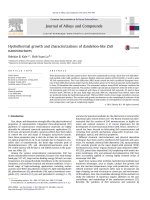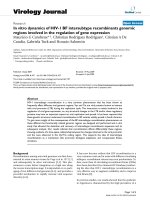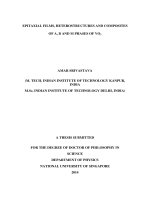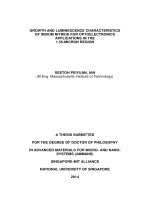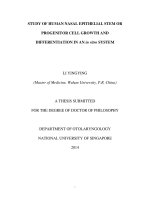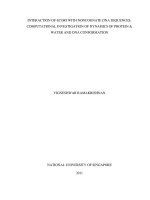Dynamics of epitaxial graphene growth and adsorptions of cobalt 1
Bạn đang xem bản rút gọn của tài liệu. Xem và tải ngay bản đầy đủ của tài liệu tại đây (1.43 MB, 34 trang )
1
Introduction & Research Objectives
There are four main objectives in this thesis i.e. (i) revisit the precursor
phase prior to formation of graphene on silicon carbide, 6H-SiC(0001)
substrate i.e. (63x63)R30
o
; (ii) to probe the dynamics and kinetics
occurring during the evolution from 63x63)R30
o
to graphene, (iii) to
investigate the growth dynamics of Co at room temperature and
comparing the similarities and differences between Co on graphene and
Co on graphite; and (iv) to investigate the change in the growth dynamic
when Co is deposited on graphene at elevated temperatures.
This chapter is organised as follows: (a) background and motivation
leading to this thesis; (b) literature reviews; (c) research objectives; and
(d) the organisation of this thesis.
Introduction and Research Objectives
2
1.1 Introduction and Motivation
The discovery of graphene has opened up a new paradigm in nanoelectronics that
could surpass the performance of conventional semiconductor devices owing to its
superior mobility that near the speed of light [1,2], anomalous half-integer quantum Hall
effect [1,3] and quasi-relativistic Klein tunneling [4]. Research on graphene, ranging from
fundamental interests to exploration of its potential as a new platform for nanoelectronics,
have been vigorously pursued since the first discovery in 2004 [5].
Graphene is essentially an isolated single sheet of graphite i.e. a two dimensional
sp
2
–bonded honeycomb lattice of carbon atoms (Fig. 1.1a). The peculiarity of its transport
properties arises from its unusual valence and conduction band. Having four valence
orbitals (2s
2
2p
2
) for each carbon atom, three of the orbitals (one s and two p orbitals)
hybridised to form three sp
2
bonding orbitals. The free lone p orbitals which oriented
perpendicular to the graphene plane hybridise to form the
(valence) and
* (conduction)
bands of graphene. At the K and K’ point of the graphene Brillouin zone (Fig. 1.1b),
these
and
* bands meet at the Fermi level, forming a zero gap. Instead of showing the
typical parabolic dependence, these bands change linearly with the momentum and
therefore the electron transport of graphene is essentially obeying the Dirac’s (relativistic)
equation (Fig. 1.1c). Owing to this, the electrons behave like massless Dirac fermion
*
and
gives rise to many interesting Dirac-properties mentioned above. With the emergence of
graphene, there is thus a tremendous interest to integrate graphene, carbon nanotubes and
fullerenes together as a platform for fully carbon-based nanoelectronics.
*
Because
and
* band touching each other, the Dirac point also coincides with the Fermi level, hence the
name Dirac fermion.
Chapter 1
3
Fabrication of graphene-based devices requires reliable and convenient process
for mass production. Mechanical exfoliation, which was the first method employed to
produce ‘free-standing’ graphene in the laboratories [1,3,5], involves lifting off several
layers of graphene sheets from a graphite crystal using adhesive tape and transfer onto the
SiO
2
as supporting substrate. This method produces high quality flakes of graphene but it
is time consuming and impractical for large-scale production as it lacks consistency in
reproducing flakes of the same sizes. Apart from this method of preparation, there are
also several avenues to produce graphene on a larger scale. These includes epitaxial
growth via solid-state decomposition of silicon carbide (SiC) at above 1200
o
C [6,7,8,9]
and cracking of a carbon carrying gas on a metallic surface [10,11,12]. Of all these
methods, the solid-state decomposition of SiC is perhaps the most direct route to prepare
Fig. 1.1 (a) A graphene sheet with atomic arrangement of carbon atoms in a 2-dimensional
honeycomb lattice. The sp
2
bonding gives shorter (1.42 Å) C-C bonding. The unit cell of
graphene with lattice parameter of 2.46 Å is also drawn. Grey and red spheres represent the two
different sublattice of graphene. The basic vectors a
1
and a
2
of the lattice are shown; (b) the first
Brillouin zone of the honeycomb lattice and (c) the linear dependence of conduction (
) and
valence (
*) bands around K and K’ points.
1.42Å
2.46Å
(a) (b)
(c)
a
1
a
2
K
M
K
’
k
x
k
y
k
y
k
x
K
K
’
K
K
K’
K’
*
E
k
Introduction and Research Objectives
4
graphene. Besides being able to produce graphene epitaxially, it is also compatible and
easier to integrate with current Si-based CMOS technology. It has been reported that the
thicknesses ranging from single to multiple layers graphene can now be prepared
depending on the growth parameters. Recent reported works have also showed the
possibility to tune (opening) the band gap of graphene via substrate effects from SiC, thus
bring this material a step closer to realise carbon-based nanoelectronics [13,14,15,16].
*
Some of the unique properties of exfoliated graphene, however, fail to replicate
themselves in SiC supported graphene (hereafter epitaxial graphene). Despite having
identical atomic structure with the exfoliated graphene and having demonstrated that the
and
* bands obey Dirac’s equation [14,16,17], epitaxial graphene exhibits some
dissimilarities to those exfoliated graphene [18]. These includes for example, (i) the
absence of the quantum Hall effect and this has been attributed to the weak localisation
imparted from coupling with underlying substrate [18], (ii) a reduced carrier mobility by
two orders of magnitude even after formation of wide terraces (which should aid in
reducing electrons scattering) [19] and (iii) instead of forming zero band gap, a small gap
is observed between
and
* [13,14,15]. At present, it has also been suggested that the
first graphene layer interacts weakly with underlying substrate where the unshifted
*
states and a pinned Fermi level at ~3 eV observed for graphene are similar to graphite
characteristics [7,17]. This observation does not explain the disparity of properties
between exfoliated and epitaxial grown graphene supported on SiC substrates.
One of the main challenges in resolving these discrepancies is because epitaxial
*
The biggest hurdle to utilise graphene as an electronic material is its zero gap property at Dirac point,
which makes the switch-off mode in a transistor becomes impossible.
Chapter 1
5
graphene is supported on a rather complex interfacial structure whose electronic and
structural details are still not well understood. The growth of epitaxial graphene from the
Si-terminated SiC(0001) is known to occur when the surface becomes increasingly
carbon (C) rich due to gradual depletion of Si during thermal annealing. This SiC(0001)
surface undergoes a series of surface reconstruction which is increasingly deficient in Si
and the formation of graphene takes place when a C-rich phase known as (63x63)R30
o
(hereafter 63 for short) has formed and annealed to temperatures above 1200
o
C [7].
Despite being first discovered in 1975 [20], the structural details of this 63 phase are still
in debate. There are several different and contrasting structural models reported in the
literature. A more thorough review of these various models will be given in Section 1.3
(Literature Reviews). The problem becomes more complicated when it was found later
that the decomposition of this initial surface to form graphene also resulted in the
formation of a new 63-like phase at the interface between the graphene surface and the
SiC substrate [15,21,22].
Clearly, the structure and the nature of interactions (covalent vs van der Waals) at
the graphene/interface and together with defects/impurities/lattice strains are anticipated
to cause scattering of charge carriers and change the transport properties of graphene. For
these reasons, it is of interest to revisit this structure and elucidate the salient features
leading to formation of epitaxial graphene on the SiC substrates. Providing an insight into
the structure of 63 will allow better understanding of the interface-graphene interaction
(covalent vs. van der Waals), growth mode and properties of epitaxial films produced.
Knowledge of the mechanism leading to the formation of graphene monolayer will also
allow the fabrication process to be tailored to control the thickness of graphene and also
improve the quality and properties of graphene.
Introduction and Research Objectives
6
Being a platform for nanoelectronic, it is unavoidable that graphene will come in
contact with metal to form electrical contact. As the technology node always continue to
miniaturise, understanding and probing the interaction of graphene with metal at atomic
level becomes indispensable. Another added-value for using graphene as host for metal
studies is its “inertness” which may prove to be an excellent supporting surface for
formation of magnetic dots/ clusters of a few hundred atoms. Technology exploitation of
cluster with properties superior than the bulk requires them to be supported on surfaces or
embedded in matrices. However, the superior cluster size-dependant magnetism which
comes from additional orbital moments [23], often altered or disappeared when these
orbitals interacts with or perturbed by the support or the medium. For example, non-
magnetic Ru has shown the importance of this aspect when its supported clusters display
4d ferromagnetism on inert graphite [24] but appear non-magnetic on noble metals such
as Ag and Au [25].
For the film materials, Co appears to be an ideal candidate due to its
ferromagnetism. Free Co clusters have been reported to be more magnetic than bulk for
sizes up to 400 atoms [23]. In addition, recent computation by Xiao et al. shows that Co
dimer adsorbed on a C(0001) surface displays the highest perpendicular magnetic
anisotropy energy (MAE) (~100 meV per atom) [26]. This reported value is about an
order higher than the next giant MAE reported from Co adatoms on Pt(111) [27,28]. For
this reason, Co/graphene system will be vital for future molecular magnetic storage [29].
Given that properties at the nanoscale are sensitive to the interaction at interface and also
the morphology (island sizes, densities and distributions), there is therefore a need to
Chapter 1
7
understand and control the growth kinetics and dynamics involved in producing these
atomic clusters. The importance of this is further spurred by recent controversies
involving Co/C(0001) system. At ambient temperature, we have found that Co nucleate as
metallic 3-dimensional clusters that physisorbed on graphite surface [30]. However,
results from computational work has been contradictory with some suggested strong
binding between Co and graphene sheet [31,32] while other proposed weak binding i.e.
physisorption [33]. Up to now, there is no experimental study reported for Co on
graphene.
It is also fundamentally interesting to probe the dynamics of a system involving
two elements of very different surface energy. Similar to graphite, graphene is expected
to possess very low surface energy. This has been recently confirmed via the liquid
droplet test [34]. In this instance, the surface energy of Co (2709 mJ/m
2
) [35,36] is almost
fifty times higher than graphene monolayer (46.7 mJ/m
2
) or graphite flakes (54.8 mJ/m
2
)
[34]. Hence the dynamics of Co on graphene at elevated temperature may totally draw a
very different picture. When the system is energetically allowed, such a huge difference
in surface energy will vigorously drives the system to minimise the total surface energy.
This is normally achieved by either (i) Ostwald ripening to form bigger islands on the
surface, or (ii) adsorbates are embedded inside the substrate. The second scenario is
particular interesting where this mechanism can be use to form embedded magnetic dots
or to form layered structure. Although the second scenario is not often reported in
comparison to surface coalescence, surface burrowing of gold (Au) by (Bi) surface [37]
and Co cluster by Au surface [38] have been observed. For the case of metal deposited on
graphite or graphene surface, embedding of adsorbate will result in formation of graphite
(or graphene)-intercalated structure. In this case, Co may insert into graphene as
Introduction and Research Objectives
8
individual atoms or clusters. A 2D magnetism of Co is also possible when Co is
sandwiched in between two layers of graphene epitaxially grown from SiC. Thus far
surface intercalation between graphene and underlying SiC substrate are reported for Ni
[39] and more recently Au [40]. The dynamic and energetics for surface intercalation has
yet to be fully understood as the study of metal intercalation underneath graphene is still
relatively new. More rigorous studies are required since this structure may give rise to
properties similar to the graphite-intercalated-compounds (GICs).
In summary, there are four main goals in this work. They are (i) revisit the
(63x63)R30
o
precursor phase structure prior to formation of graphene on 6H-SiC(0001)
substrate; (ii) to probe the dynamics and kinetics occurring during the evolution from
63x63)R30
o
to graphene, (iii) to probe and compare the similarity and difference
between the growth dynamics of Co on graphene and Co on highly oriented pyrolytic
graphite (HOPG) at room temperature and (iv) the dynamics of Co on graphene at
elevated temperatures where surface burrowing of Co is observed in this work.
In the next section, the controversies involving the precursor phase of graphene i.e.
63 phase will be reviewed. Various structural models have been proposed for the 63
phase. The significance and short falls of these models will be compared. The current
status of the graphene growth dynamic on SiC is also discussed in this section. The
section ends with review on metal adsorption on graphene and graphite, which will
provide the background to the third and fourth objective of this thesis.
Chapter 1
9
1.2 Literature Reviews
1.2.1 (63x63)R30
o
: the precursor phase prior to graphene/6H-SiC(0001)
The structure of hexagonal SiC(0001) and various phases leading to epitaxial
graphene will be discussed prior to review of the 63 phase. Emphasis is given to 6H-
SiC(0001) since our preliminary studies found this polytype produces better quality of
epitaxial graphene than 4H-SiC(0001).
(i) Introduction to crystal structure of 6H-SiC(0001)
Figure 1.2a shows a single unit of Si-C structure that consists of a Si atom bonded
to four nearest C atoms (or vice versa) via sp
3
bonding network with tetrahedral angle of
109.5
o
. This single unit of Si-C structure is the building block for all the polytypes of SiC.
For hexagonal polytypes, repeating this unit in two directions as shown in Fig. 1.2b gives
rise to a (0001) plane of the hexagonal SiC. A SiC bilayer (BL) is defined as a layer
consists of Si alternating with the nearest C layer along a direction, in this case the [0001]
direction. In a hexagonal symmetry, there are three positions (A, B or C) which the layers
can be stacked along the [0001] with each position rotated 60
o
from one another (Fig.
1.2c). A change in the stacking sequence resulted in change of the unit cell or a new
polytype.
Introduction and Research Objectives
10
Fig. 1.2 (a) A single unit of Si-C structure; (b) translation of this unit structure along two
directions perpendicular to [0001] direction creates the (0001) plane of hexagonal SiC; (c) the
orientation of next layer can be the same or rotated by 60
o
. This rotation creates many polytypes
of SiC; (d) cross section view of a 6H polytype as projected on the (11
2 0) plane. The switch of
stacking sequence occurs after the third SiC bilayer (from top) and (e) half of a unit cell of 6H-
SiC(0001). The top views i.e. (0001) plane for both full and half unit cell in (c) and (d) are also
provided at the bottom. The top views show that due to switch in stacking sequence by 60
o
, the
unit cell (solid line diamond) is rotated 60
o
when a 6H unit cell is terminated at half a unit cell.
Side view
Top view
60
o
(a) (b) (c)
Top view
(d)
(e)
off-bond
on-bond
3.08 Å
(1.89 Å)
[0001]
[1100]
[0001]
[1100][1100]
15.12 Å
(0.63 Å)
7.56 Å
A
B
C
A
C
B
A
Si
C
1 BL
Layer 1
Layer 2
[0001]
Top view
Chapter 1
11
The most common polytypes for hexagonal (H) SiC is 2H (ABAB), 4H (ABAC)
and 6H (ABCACB). The crystal structure of 6H polytype is shown in Fig. 1.2d with 6 BL
stacked in a sequence of ABCACB (with reference to position of Si atoms). The average
Si-C bond length is 1.89 Å, the vertical distance for a Si-C off-bond (bonded sidewise) is
0.63 Å and hence the interlayer distance between Si-Si layers is 2.52 Å (see Fig. 1.2d).
The cell parameters are a = 3.08 Å (the nearest distance between two Si or C atoms) and c
= 15.12 Å (height of one unit cell of 6H i.e. 6*2.52 Å). The top view of the (0001) plane
is also illustrated in Fig. 1.2d with the unit cell drawn as solid line. The switch of stacking
sequence occurs after the third SiC bilayer with the unit cell rotated 60
o
. Furthermore,
there are two possible polarities of the crystal, where in the case of bulk truncation with
Si-C bilayer intact, the (0001) surface is Si-terminated, while the (000
1) surface is C-
terminated [41].
(ii) Surface reconstruction and phases of 6H-SiC(0001)
The Si-terminated surface of 6H-SiC(0001) undergoes various phases when
heated under ultra-high vacuum (UHV) conditions to different temperature regimes.
These phases are in local equilibrium with the annealing temperature and evolve from Si-
rich to the more thermodynamically stable C-rich phases. As-received SiC wafers are
normally covered with layers of native oxides. To remove the native oxide and passivate
the surface prior to vacuum preparation, the substrates are normally chemically treated
using methods similar to hydrofluoric acid (HF) etching of oxides on silicon [42,43,44].
However this ex-situ preparation is not sufficient to prepare atomically clean surface. In
principal, the clean surface can be prepared by heating the surface under UHV conditions
Introduction and Research Objectives
12
at temperatures above 800
o
C. The oxides are normally removed as volatile SiO
x
species.
Due to uncontrollable removal of Si from the Si-terminated 6H-SiC(0001), defects are
normally generated. To minimise these defects, an external supply of Si flux is normally
used during heating or annealing such that the arriving Si will “etch” away the oxides on
the surface as SiO
x
and hence minimise the desorption of the intrinsic Si from bulk SiC.
When the clean surface is prepared without external Si source, the SiC(0001) surface will
transform from 1x1 to (3x3)R30
o
reconstruction [44]. However if Si flux is used, a Si-
rich phase i.e. 3x3 is observed due to higher supersaturation of Si on this surface [45]. As
the surface is heated to higher temperature regimes, various other phases are created due
to continuous sublimation of Si with temperature. Important phases (ascending with
temperatures) that consistently observed by others are (3x3)R30
o
(between 900 to
1000
o
C), (63x63)R30
o
(between 1050
o
C to 1190
o
C) and finally the graphitised phase
(above 1200
o
C) [46,47,48,49,50]. Auger electron spectroscopy (AES) shows that surface
prepared using Si flux are Si rich for the 3x3 and (3x3)R30
o
and C-rich for 63 before
the surface becomes completely graphitised [49]. Equation (1.1) shows the surface
transition:
SiC-1x1
3x3
(
3x
3
)
R30
o
(63x63)R30
o
Graphene
+Si
,
~850
o
C ~950
o
C ~1070
o
C ~1200
o
C
- SiO
x
-
Si
-
Si
(1.1)
-
Si
Chapter 1
13
Fig. 1.3 Left panel shows filled-state STM images and the respective LEED pattern as the 6H-
SiC(0001) undergoes from 3x3 [51], (
3x3)R30
o
[52], (63x63)R30
o
[52] and finally the
graphitised states [53,54] as the surface is annealed with increasing temperatures. The surface
transforms from Si-rich to C-rich as Si is gradually desorbed from the surface. The 1x1 LEED
diffraction pattern is highlighted using six white circles. Except 6
3 and graphitised phase, the
right panel shows the well-received structural model proposed for the 3x3 [57] and
3 phases
[
58
]
.
?
Carbon rich Silicon rich
~950
o
C
~1070
o
C
Si
SiC
bulk
Si
SiC
bulk
Si
SiC
bulk
Si
SiC
bulk
3x3
5.3 Å
5 Å
3x3
1x1
3x3
1x1
63x63
5 Å
32.0 Å
3x3
9.
2
Å
5 Å
1 x 1
3x3
9.
2
Å
5 Å
1 x 1
~850
o
C
~1200
o
C
graphene
63 (?)
graphene
2
.
5
Å
1x1
3x3
(
3x3)R30
o
(6
3x63)R30
o
Graphene
Introduction and Research Objectives
14
Left panel of
Figure 1.3 shows the scanning tunneling microscopy (STM) images
and the corresponding low-energy electron diffraction (LEED) pattern of the 3x3 [51],
(3x3)R30
o
[52], (63x63)R30
o
[52] and graphitised 6H-SiC(0001) [53,54] as the 6H-
SiC(0001) surface is progressively annealed from 850
o
C to above 1200
o
C. Based on the
quantitative analyses of Si and C intensities obtained from AES [49] and X-ray
photoelectron spectroscopy (XPS) [ 55 ], the 3x3 and (3x3)R30
o
surface are still
relatively Si richer than the SiC-1x1 bulk. In addition, XPS results also reveals elemental
Si signals which suggest the protrusions imaged under STM for these surfaces are
resulted from Si clusters. Since then, several models have been put forward to elucidate
the 3x3 [45,56,57,58] and (3x3)R30
o
phase [44,58,59,60,61]. The well-received
structural model of these two phases is presented in the right panel of Fig. 1.3.
The 3x3 structure that proposed by J. Schardt et al. [57] consists of Si tetramers
sitting on top of a full Si adlayer which itself sits on top of the bulk Si-terminated
SiC(0001) surface. The (3x3)R30
o
unit cell which is 3 times smaller than 3x3 surface
is easier to elucidate. Several groups thus far have agreed on a model where a Si adatom
sitting at the T4 site of the bulk Si-terminating layer of SiC(0001) [44,58,59,60,61]. This
configuration attracts the Si atoms from bulk towards the Si adatoms and induced
buckling of first C sub-layer (Fig. 1.3). By comparison, the Si density from the 3x3 model
is higher than the 3, which is in agreement with the AES and XPS observations [49,55].
Chapter 1
15
(iii) Controversies related to (63x63)R30
o
reconstruction of 6H-SiC(0001)
Since the first discovery back in 1975 [20], the structure of (63x63)R30
o
(hereafter 63 for short), which is the precursor phase for graphene, is still in
controversies. The first controversy comes from disparity between the LEED diffraction
pattern and the STM of this surface. While the LEED strongly suggests this surface has a
long-range order of 63 periodicity, STM suggests otherwise. Filled-state STM images in
Fig. 1.4a-c shows that the surface is predominantly a 6x6 reconstructed surface. The
imaging of this surface under STM is also staggering where it can manifest in a few
different features while maintaining a strong 6x6 periodicity as shown in Fig. 1.4a-d. In
Fig. 1.4 Various filled-state STM images of the (63x63)R30
o
observed by different groups.
Image (a), (b), (c) and (d) are extracted from Refs. 52, 62, 63 and 53 respectively. The 6x6 unit
cell is drawn in each STM image except d(iii).
(a)
(b) (c)
(d)
2.0V, 0.3nA
18.5Å
6x6
6x6
6x6
6x6
6x6
63
0.2V, 0.3nA (16nm x 8nm)
32 Å
(i)
(ii)
(iii)
1.8 V, 0.13nA
2.5 V, 0.2 nA.
2.5 V, 60 pA.
1.7V, 0.3nA
Hexagonal
Pentagonal
Introduction and Research Objectives
16
Fig. 1.4a, Mårtensson et al. observed the 63 surface seems to be decorated with 6x6
trimer-like clusters with individual clusters scattering around the trimers [52]. Chen et al.
on the other hand observed this phase as a surface with 6x6 protrusions (Fig. 1.4b [62]) or
a 6x6 honeycomb (Fig. 1.4c [63]). More recently Riedl et al. also observe this surface
consists of trimers similar to Mårtensson et al. (Fig. 1.4d(i)) [53]. In addition, they also
claimed they observed rings of two different sizes and shapes where the bigger ring is
hexagonal while the slightly smaller ring is pentagonal (in Fig. 1.4d(ii) and (iii)). They
suggest that the alternate arrangement of these two rings can give rise to the 63
periodicity and hence bridge the observation of STM to the LEED pattern observed.
The efforts to resolve the structure of 63 surface are also impaired by the
complexity of this surface. As the AES and XPS in general revealed the Si/C ratio of this
surface ranges between 1.6 to 0.6 [49,55], debates have been ongoing whether this
surface is fully C-terminated or mixture of both Si and C elements. In general, most of the
research groups assume this surface is fully C-terminated [7,63]. However recent
published reports suggest that this 63 surface still consists remnant of Si that are
responsible for the bright 6x6 protrusions observed under STM [21,64].
Beginning with models proposed based on a fully C-terminated 63 surface, the
first model has been put forward by van Bommel et al. where based on their LEED result,
they suggested the 63 surface consists of a graphite monolayer resting above a bulk-
truncated SiC surface [20] (see Table 1.1, Model 1). This is because in real space, a 30
o
rotated mesh of 13x13 unit cells of graphene matches exactly a (63x63)R30
o
unit cells
of SiC(0001). This model initially seems accurate when Chang et al., via STM and STS,
found a graphene layer terminating the SiC surface [65]. Others proposed that the
Chapter 1
17
graphene overlayer rest above a 3x3 surface (Table 1.1, Model 2) instead of 1x1 bulk
[7,47,66]. However the presence of a graphene overlayer is later disputed by Mårtesson et
al. when they do not find any signature for graphene from their photoemission studies
[67], which later confirmed by their STM studies [68]. Instead, they attributed the 63
diffraction is a collective diffraction from 5x5, 6x6 and 3x3 phases co-exist on their
surface [68]. The disparity between these results is later attributed to the 63 phase
formed at the interface beneath the graphene layer. This structure (graphene/63/SiC)
gives rise to 63 diffraction pattern while at the same time graphene lattice is imaged
under STM [52] (this can be seen in Fig. 1.3 where STM of the graphitised 6H-SiC(0001)
showing 6x6 honeycomb beneath the graphene monolayer). As the graphene layers grow
thicker, both of the diffraction from SiC-1x1 and 63 patterns become diffuse and
disappear with a new 1x1 diffraction originated from graphene layers emerged [7]. This
new 1x1 pattern rotated 30
o
from SiC(1x1) and consistent with STM imaging where the
graphene layer rotated 30
o
from SiC. More recently, Chen et al. proposed a different
model for the 63 phase (see Model 3) [63]. Based on the STM imaging and the intensity
ratios and binding energies of various C 1s components recorded from their
photoemission studies, they proposed a fully C-terminated 63 surface. However, instead
of covering the surface with graphene, they suggested that the 6x6 honeycomb observed
under their STM imaging (Fig. 1.4c) arises from carbon clusters of two different sizes
bonded via sp
3
bonding. Surrounding these clusters are small graphene islands. Their
structure however is at odd with spectroscopy studies reported by others where large
amount of non-graphitic carbons and presence of Si are observed [67].
Several recent work continues to report detection of Si-related structures on this
Introduction and Research Objectives
18
C-rich 63 surface [21,64,69,70]. Via XPS measurements, Ong et al. observed that
elemental Si continuously to be present on their 63 surface although the amount
decreases gradually from their initial Si-rich 3x3 surface [64]. This prompts them to
propose that this elemental Si originated from remnants of Si from pre-cursor phases
which are Si-rich i.e. the 3x3 and 3x3. Using the result by Grass et al. which postulate
four Si atoms form stable cluster on graphite [71], they systematically remove M unit of
Si tetramer from the 3x3 and 3 surfaces and arrived at a final structure with
arrangements of Si clusters and C-rich region that is similar to the 6x6 honeycomb (see
Model 4). Rutter et al. also found pyramidal clusters akin to Si tetramers on the 63
structure (Model 5) [21]. While elemental Si on 63 phase continues to be detected by
others recently [70], some other groups continue to believe the 63 surface is fully C-
terminated surface with a graphene layer resting on the SiC(0001) [72].
Perhaps the closest 63 model comes from these two work by Kim et al. [73]
(Model 7) and Varchon et al. [74] (Model 8). Both of these groups proposed that the 63
periodicity comes from a layer of graphene sitting above Si-terminated SiC(0001). Due to
mismatch between the SiC(1x1) and graphene-(1x1)R30
o
, not all C atoms are bonded to
Si. The C atoms that covalently bonded to the underlying Si form a 3x3 periodicity
while the unbonded C atoms form
bonding with the nearest unbonded C atoms. This
arrangement of both bonded and linkage of unbonded C atoms creates a 6x6 quasi-
periodic of superhexagonal structure which they claimed is coherent with the 6x6
periodicity observed under STM imaging. The bonded (unbonded) C atoms are found
attracted towards (retracted) the bulk SiC. Hence the bonded C atoms with 3
arrangement creates the “hole” while the retracted
-bonded carbon form the bright
Chapter 1
19
protrusions observed in STM (Figs. 1.4b-c). Akin to STM observation by Riedl et al.,
their simulation of the surface shows hexagonal rings of different sizes and shape.
However the simulated images do not match the trimers observed in Fig. 1.4a and 1.4d(i).
The vast amount of sp
3
type of C-C components observed by photoemission studies of
Mårtesson et al. [67] are also not found in their model. Similar to earlier thought, both
work rebuff the idea of Si clusters being present on this 63 surface.
For comparison and convenience, all of the abovementioned models are tabulated
in Table 1.1. They are arranged in an order ascending the year they were reported. It is
clear that despite the continuous effort in resolving the 63 surface, there is still no
consensus achieved for this 63 surface. Clearly resolving the structure will be useful in
aiding the understanding of its role in the growth of graphene and the resulting properties.
Introduction and Research Objectives
20
Table 1.1 List of structural models proposed for (6
3x6
3)R30
o
surface.
20
7
63
YearDescriptions of the structure
Proposed (63x63)R30
o
structure
2005 [ ]
The 63 surface is assumed
terminated by a 6x6 structure
based on the STM images
which shows 6x6 honeycomb
structure. Model proposed
based on STM images, XPS
intensities and the binding
energy of various C 1s
components. The surface is
terminated with sp
3
carbon
clusters of two different sizes
and they self-organised to form
6x6 honeycomb. They are also
surrounded by small graphene
islands.
1998 [ ]Based on inverse
photoemission studies and
LEED pattern. Authors
suggested a graphene
monolayer rests on top of a 3
surface that consists of Si
adatoms. The graphene was
oriented 30
o
from bulk-1x1.
The four Si adatoms (marked
by ) at the corner of 13 x 13
graphene cell coincide with the
troughs of the honeycomb
lattice and thus give rise to the
four nodes of the
(63x63)R30
o
unit cell.
1975 [ ]The SiC-1x1 is terminated
with a graphene overlayer.
This model was proposed
based on LEED pattern where
63 diffraction pattern was
observed. In this instance, the
length of a (63x63) SiC cell
matches with 13 times the
length of a (1x1) graphene unit
cell.
YearDescriptions of the structure
Proposed (63x63)R30
o
structure
2005 [ ]
The 63 surface is assumed
terminated by a 6x6 structure
based on the STM images
which shows 6x6 honeycomb
structure. Model proposed
based on STM images, XPS
intensities and the binding
energy of various C 1s
components. The surface is
terminated with sp
3
carbon
clusters of two different sizes
and they self-organised to form
6x6 honeycomb. They are also
surrounded by small graphene
islands.
1998 [ ]Based on inverse
photoemission studies and
LEED pattern. Authors
suggested a graphene
monolayer rests on top of a 3
surface that consists of Si
adatoms. The graphene was
oriented 30
o
from bulk-1x1.
The four Si adatoms (marked
by ) at the corner of 13 x 13
graphene cell coincide with the
troughs of the honeycomb
lattice and thus give rise to the
four nodes of the
(63x63)R30
o
unit cell.
1975 [ ]The SiC-1x1 is terminated
with a graphene overlayer.
This model was proposed
based on LEED pattern where
63 diffraction pattern was
observed. In this instance, the
length of a (63x63) SiC cell
matches with 13 times the
length of a (1x1) graphene unit
cell.
SiC
bulk
Graphene overlayer
Unit cell of SiC(0001)
Unit cell of graphene layer
Graphene honeycomb lattice
Si-terminated 6H-SiC(0001) bulk
3Si adatoms
C
sp
3
C
clusters
Graphene
islands
Model 1
Model 2
Model 3
Chapter 1
21
YearDescriptions of the structure
Proposed (63x63)R30
o
structure
2007 [ ]No structural model is put
forward but the authors
claimed that they observed the
63 periodicity from the STM
image which link to the 63
pattern from LEED. The 63
periodicity comes from rings
of two different sizes (marked
by hexagonal dark gray and
pentagonal light gray shaded
area).
2007 [ ]Based on their STM imaging
of graphitised 4H-SiC(0001),
they observed pyramidal
structure similar to Si tetramer
at the interface with 63
periodicity. In their final
structure, the 63 structure
consists of Si tetramer and T4
Si adatoms.
2006 [ ]Model proposed based on
STM images, clusters size
measurement and XPS results.
Similar to Ref. , the 63
surface is observed terminated
by 6x6 honeycomb. However,
unlike other models which
suggested a fully C-
terminated surface, they
proposed the surface still have
remnants of Si clusters that
left over from the 3 surface,
as suggested by detection of
elemental Si signals (XPS).
They arrived at this structure
by systematically remove n
unit of Si
4
tetramer starting
from a 3x3 surface.
YearDescriptions of the structure
Proposed (63x63)R30
o
structure
2007 [ ]No structural model is put
forward but the authors
claimed that they observed the
63 periodicity from the STM
image which link to the 63
pattern from LEED. The 63
periodicity comes from rings
of two different sizes (marked
by hexagonal dark gray and
pentagonal light gray shaded
area).
2007 [ ]Based on their STM imaging
of graphitised 4H-SiC(0001),
they observed pyramidal
structure similar to Si tetramer
at the interface with 63
periodicity. In their final
structure, the 63 structure
consists of Si tetramer and T4
Si adatoms.
2006 [ ]Model proposed based on
STM images, clusters size
measurement and XPS results.
Similar to Ref. , the 63
surface is observed terminated
by 6x6 honeycomb. However,
unlike other models which
suggested a fully C-
terminated surface, they
proposed the surface still have
remnants of Si clusters that
left over from the 3 surface,
as suggested by detection of
elemental Si signals (XPS).
They arrived at this structure
by systematically remove n
unit of Si
4
tetramer starting
from a 3x3 surface.
3.8Å3.8Å
Si
atoms
Si tetramer
T4 Si adatom
Model 4
Model 5
Model 6
STM image
53
21
64
63
Introduction and Research Objectives
22
72
74
2008 [ ]
The 63 surface is terminated
with a graphene layer bonded
to the top Si layer of the bulk
SiC. This graphene layer is
rotated 30
o
from the SiC bulk
so that the (63x63)R30
o
of
SiC(0001) coincidence with
13x13 of the graphene mesh.
Due to mismatch between the
SiC(1x1) and graphene(1x1),
not all C atoms are bonded to
the Si adatoms. The bonded C
atoms creates a 3 periodicty
while the unbonded C atoms
form bonds with the
neighbouring unbonded C
atoms (black lines in bottom
image). The arrangement of
bonded and unbonded C atoms
gives rise to 6x6 quasi-periodic
arrangement. The bonded
(unbonded) C atoms are
attracted towards (retracted
from) the surface and
responsible for the hole (bright
protrusions) of 6x6
honeycomb structure observed
by STM.
YearDescriptions of the structure
Proposed (63x63)R30
o
structure
2008 [ ]Same discussion as Model 7.
2008 [ ]
The 63 surface is terminated
with a graphene layer bonded
to the top Si layer of the bulk
SiC. This graphene layer is
rotated 30
o
from the SiC bulk
so that the (63x63)R30
o
of
SiC(0001) coincidence with
13x13 of the graphene mesh.
Due to mismatch between the
SiC(1x1) and graphene(1x1),
not all C atoms are bonded to
the Si adatoms. The bonded C
atoms creates a 3 periodicty
while the unbonded C atoms
form bonds with the
neighbouring unbonded C
atoms (black lines in bottom
image). The arrangement of
bonded and unbonded C atoms
gives rise to 6x6 quasi-periodic
arrangement. The bonded
(unbonded) C atoms are
attracted towards (retracted
from) the surface and
responsible for the hole (bright
protrusions) of 6x6
honeycomb structure observed
by STM.
YearDescriptions of the structure
Proposed (63x63)R30
o
structure
2008 [ ]Same discussion as Model 7.
Model 7
63 unit cell
Model 8
6x6
63
3
Bonded to substrate
C atoms (void)
Unbonded C atoms
(
-bonding)
Unbonded C atoms
(
-bonding- linked
using black lines)
Bonded to substrate
C atoms (gray balls)
Chapter 1
23
1.2.2 Growth of epitaxial graphene on SiC substrates
The study of graphene growth from SiC has been lacking prior to discovery of
graphene. Currently this interest is renewed since epitaxial growth on 6H-SiC(0001)
offers large scale production and more importantly epitaxial graphene produced this way
shows some Dirac properties similar to those free standing graphene [14,16,17]. While it
is known that graphene evolves from the C-rich 63 surface, there are not many work that
address the dynamics and kinetics by which this transformation occurs. Below are the
summary of the current understanding of epitaxial growth of graphene on SiC(0001):
(i) using low-energy electron microscopy (LEEM) technique, Hannon et al. provided a
real time in-situ observation of the formation of graphene [75]. In their work, they
observed graphene growth begins with pit formation on the surface due to pinning of the
precursor phase, 63. They also observed that three BL of the 6H-SiC(0001) surface
collapsed during the formation of 63 reconstruction prior to graphene formation. This
prompt them to suggest that the 63 layer consists carbon equivalent to 3 BL of SiC
which by coincidence fulfil the carbon ratio needed to form a monolayer of graphene;
(ii) via ex-situ transmission electron microscopy (TEM), Borysiuk et al. observed
graphene monolayer draping across the atomic steps of SiC, giving rise a carpet-like
structure [76]. However because their observations were made ex-situ, they could not
predict the growth mechanism adopted by the surface as it transforms from 63 to
graphene;
Introduction and Research Objectives
24
(iii) recent reported work involved annealing the surface gradually between the
temperature regime of graphitisation (1200
o
C to 1400
o
C) and investigating the surface
morphology in particular the step densities as their surface is progressively heated [77,78].
Both of this work observed atomic steps as the main source for releasing the Si atoms and
graphene formation begins at these borders. Their observations are in agreement with our
work reported earlier [30]. Using electron channeling contrast imaging, Ferralis et al.
observed that the film thickness is mainly determined by growth temperature [79]. In
addition they found that increasing the annealing time beyond 8 minutes at constant
temperature leads to pinning of graphene films at step edges, resulting in compressively
stressed films at room temperature which may be responsible for the blue shift observed
for the optical phonon of epitaxial graphene, and
(iv) recent STM imaging of graphitised SiC(0001) surface revealed that the epitaxial
graphene rest on an interface that mimic the same filled-state images of 63 phase. These
studies show that as the initial 63 surface converts to graphene, a new 63-like layer
also forms concurrently at the interface between graphene and the SiC bulk [22,30,80].
The interface with 63-like structure is consistently recorded over a wide range of
tunneling conditions due to the “partial transparency” of graphene layer above it. This has
made the study of the evolution of graphene from the 63 surface challenging as it is
difficult to distinguish between areas that are covered with graphene and 63. For these
reasons, the mechanism leading towards the graphene formation has not been investigated
in detail.
Chapter 1
25
1.2.3 Metals on graphene
(i) Co adsorption studies
Adsorption of metal on graphene has been actively studied, mostly using
computational method due to huge interest in utilising graphene as platform for carbon
based nanoelectronics [33,81,82,83]. Most of the computational work reported strong
interaction between Co (covalent bonding) and single layer graphene [31,32]. However
recent work shows otherwise [33] where interaction of physisorption nature is reported.
All of these reports predict Co preferentially adsorb on top of the hole of the honeycomb
graphene lattice. Table 1.2 summarised the adsorption energy and bond strength of Co on
graphene calculated using the density functional theory (DFT). Magnetic moment and
charge transfer from Co to graphene are also provided as reference.
Table 1.2 The preferred adsorption site, adsorption energy, bond length, vertical distance of Co
from graphene, magnetic moment and charge transfer from Co adatom to graphene as predicted
by calculation using density functional theory.
Preferred
adsorption
sites
Adsorption
energy
(eV)
Adatom-
C bond
length
(Å)
Vertical
distance of
adatom from
graphene
plane (Å)
Magnetic
moment (
B
)
Adatom to
graphene
charge
transfer (
e)
Reference
Hole 1.27 2.12 - 1.31) - 81
Hole 1.32 2.09 1.56 1.1 1.1 83
Hole 0.97 - 1.51 1.0 0.6 33
Hole 2.4 - 1.52 1.0 0.2 31
Hole 1.58 2.10 1.49 1.0 - 32
*E(adsorption) = E(adatom+graphene) − E(graphene) − E(adatom)

